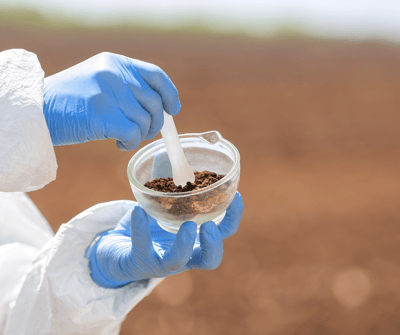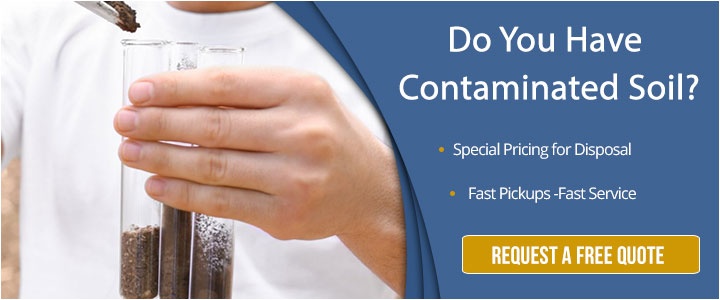When a site is contaminated, an environmental risk assessment outlines the health risks that may come with exposure. The assessment is an important step in determining what comes next.
If your company is managing a site and potential soil contamination has been discovered, an environmental risk assessment helps lay the groundwork and justifies the next action you take, whether that is remediation or removal of the contamination.
Understanding the risk assessment results is crucial since it forms the basis for an effective plan to address the contamination. But what happens after an environmental risk assessment of soil contamination takes place?

Here’s what may happen with the assessment’s results and who can help implement a plan.
What Information Does A Risk Assessment Provide?
A risk assessor takes data collected from a site and develops risk calculations. Data can come from a number of sources, but is often from water, soil and air samples.
The assessor then determines the levels of contaminants that can remain at the site, especially if it’s not feasible to remove the contaminants completely.
A plan that includes key steps at mitigating the soil pollution risk involved is developed. In the case of soil contamination, steps may include restoring the soil’s health and ensuring the safety of the surrounding community. Actions taken to accomplish this can vary, however. Let’s dive into some of the possibilities of what happens after an environmental risk assessment of soil contamination occurs.
What Steps Follow An Assessment?
After conducting an environmental risk assessment of soil contamination, the next step is to implement a plan. That plan may look different depending on the amount and type of contamination.
Here are some typical steps that might follow an assessment:
- Remediation Planning: Based on the assessment findings, a soil remediation plan is developed. This plan outlines the methods and techniques that will be used to clean up or mitigate the contamination.
- Cleanup or Remediation Actions: Various methods such as excavation, soil washing, bioremediation, thermal treatment or chemical treatment might be employed to clean up the contaminated soil. The chosen method will depend on factors like the type of contaminants, their concentration and the site’s characteristics.
- Monitoring and Verification: After the remediation process, continuous monitoring is often necessary to ensure that the cleanup is effective and that contaminants have been reduced to acceptable levels. Verification sampling and testing are conducted to confirm that the remediation goals have been achieved.
- Ecological Risk Management and Control Measures: Implementing measures to prevent future contamination is crucial. This might involve better storage or handling of hazardous materials, regular inspections, installing barriers or covers or other preventive measures.
- Regulatory Compliance: Ensuring that all activities related to soil remediation comply with local, state and federal regulations is critical. This includes obtaining necessary permits, following specific guidelines and meeting reporting requirements.
- Communication and Public Awareness: Informing and involving the community or stakeholders about the findings, actions taken and potential risks of soil contamination is important. Open communication helps build trust and ensures everyone understands the situation and the steps being taken to address it.
- Long-term Monitoring and Maintenance: In some cases, long-term monitoring and maintenance of the site may be necessary to prevent any potential recontamination and to ensure that the remediated area remains safe.
- Documentation and Reporting: Detailed records of the assessment, remediation activities, monitoring results, and other related information should be maintained. Reporting to regulatory agencies or other relevant authorities may also be required depending on local, state and federal laws.
Overall, managing soil contamination involves a multi-step process that requires careful planning, execution and ongoing monitoring to ensure that risks are mitigated and the environment is restored to a safe and healthy state.
Who Can Help After An Environmental Risk Assessment?
Contaminated soil can be discovered in various situations, whether during industrial operations and construction projects or when repurposing brownfield sites. A number of substances can also contaminate soil, including:
- Heavy metals
- Petroleum hydrocarbons
- Pesticides and herbicides
- Polycyclic-Aromatic Hydrocarbons (PAHs)
- Asbestos
- Radioactive contaminants
- Chlorinated solvents
When soil pollution is discovered, it’s important to take prompt action to mitigate risks and prevent further environmental damage or health hazards. Immediate response is necessary once the nature and extent of the contamination have been determined through an environmental risk exposure assessment.
This might involve removing, treating or safely containing the contaminated soil to prevent its spread and potential harm to the surrounding environment and communities. Handling contaminated soil requires specialized expertise, equipment and adherence to strict regulatory guidelines to ensure safe and compliant disposal.
This is where a partner experienced in soil contamination disposal plays a pivotal role. The best hazardous waste disposal companies will bring in-depth knowledge, skills and resources to manage the contaminated soil effectively. Here are some of the ways they can assist:
- Expert Assessment: A reputable soil disposal company can assist with an assessment of the contamination, determining the type and extent of pollutants present. This assessment informs the appropriate disposal and remediation methods.
- Specialized Handling and Removal: Disposal companies employ specialized techniques for handling, removal and contaminated soil disposal safely. This includes using equipment designed for soil excavation and transportation while minimizing risks of spreading contaminants.
- Treatment and Remediation: Depending on the contaminants involved, the disposal company might offer treatment solutions like bioremediation or thermal treatment to reduce or eliminate pollutants from the soil, ensuring it meets regulatory standards for safe disposal.
- Compliance with Regulations: The best disposal companies will ensure compliance with local, state and federal regulations governing soil contamination disposal. This involves obtaining necessary permits, following specific guidelines and fulfilling reporting requirements.
- Safe Disposal Practices: Proper disposal methods are crucial. A disposal company should have access to appropriate disposal sites or facilities equipped to handle hazardous materials and contaminated soil, ensuring it's managed and disposed of safely and responsibly.
- Documentation and Reporting: Disposal companies should maintain detailed records of the disposal process, including proper documentation and reporting to regulatory bodies, ensuring transparency and compliance throughout the remediation process.
Engaging an experienced soil contamination disposal company is essential when faced with contaminated soil. The best companies will ensure efficient, safe and compliant management of the contamination, contributing to environmental protection and public health safety.


Comment